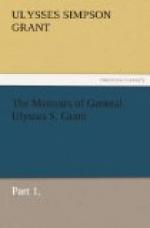The siege continued with brisk firing on our side till the 27th of March, by which time a considerable breach had been made in the wall surrounding the city. Upon this General Morales, who was Governor of both the city and of San Juan de Ulloa, commenced a correspondence with General Scott looking to the surrender of the town, forts and garrison. On the 29th Vera Cruz and San Juan de Ulloa were occupied by Scott’s army. About five thousand prisoners and four hundred pieces of artillery, besides large amounts of small arms and ammunition, fell into the hands of the victorious force. The casualties on our side during the siege amounted to sixty-four officers and men, killed and wounded.
CHAPTER X.
March to Jalapa—battle of Cerro Gordo—Perote—Puebla—Scott and Taylor.
General Scott had less than twelve thousand men at Vera Cruz. He had been promised by the administration a very much larger force, or claimed that he had, and he was a man of veracity. Twelve thousand was a very small army with which to penetrate two hundred and sixty miles into an enemy’s country, and to besiege the capital; a city, at that time, of largely over one hundred thousand inhabitants. Then, too, any line of march that could be selected led through mountain passes easily defended. In fact, there were at that time but two roads from Vera Cruz to the City of Mexico that could be taken by an army; one by Jalapa and Perote, the other by Cordova and Orizaba, the two coming together on the great plain which extends to the City of Mexico after the range of mountains is passed.
It was very important to get the army away from Vera Cruz as soon as possible, in order to avoid the yellow fever, or vomito, which usually visits that city early in the year, and is very fatal to persons not acclimated; but transportation, which was expected from the North, was arriving very slowly. It was absolutely necessary to have enough to supply the army to Jalapa, sixty-five miles in the interior and above the fevers of the coast. At that point the country is fertile, and an army of the size of General Scott’s could subsist there for an indefinite period. Not counting the sick, the weak and the garrisons for the captured city and fort, the moving column was now less than ten thousand strong. This force was composed of three divisions, under Generals Twiggs,




